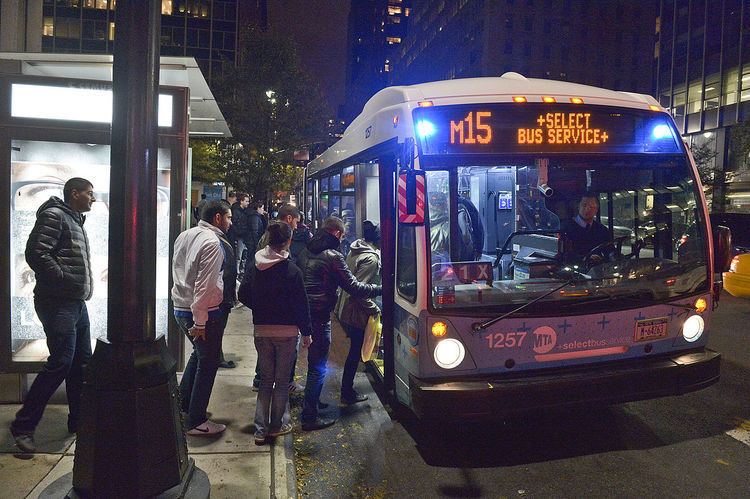Locale Manhattan | ||
 | ||
System MTA Regional Bus Operations Operator Manhattan and Bronx Surface Transit Operating Authority (MaBSTOA)
New York City Transit Authority (NYCT) Garage Tuskegee Airmen Depot (M15)
Mother Clara Hale Depot (M15 SBS) Vehicle M15:
New Flyer D60 Galaxy
Nova Bus LFS articulated
M15 SBS:
Nova Bus LFS articulated Livery M15 SBS: Select Bus Service | ||
The Second Avenue Line is a bus line in Manhattan, New York City, United States, running mostly along Second Avenue (and northbound on First Avenue since 1951) from Lower Manhattan to East Harlem. Originally a streetcar line, it is now the southbound direction of the M15 bus route, the second busiest bus route in the city (behind the Bx12) and the busiest in Manhattan, with an annual ridership of over 15.5 million. (However, the M15 is the only route on First and Second Avenues, while the one-way pair of Madison and Fifth Avenues has a higher frequency of local buses past Central Park, split among four routes (M1/M2/M3/M4). MTA Regional Bus Operations, under the New York City Bus and Select Bus Service brands, operates the local out of the Tuskegee Airmen Bus Depot and the SBS is operated from the Mother Clara Hale Bus Depot. Service is operated exclusively with articulated buses.
History
The Second Avenue Railroad opened the line in 1853 and 1854, from Peck Slip on the East River north along Pearl Street, Bowery (shared with the Third Avenue Line), Grand Street, Chrystie Street, and Second Avenue to East Harlem. A short branch was later built along Stuyvesant Street and Astor Place to end at Broadway in NoHo. The Metropolitan Street Railway leased the line in January 1898, and on April 3 the line from Astor Place to Manhattan was electrified. The original line was later electrified to the Bowery, where streetcars used the Third Avenue Line to City Hall, and the line to Peck Slip was abandoned. Buses were substituted for streetcars by the East Side Omnibus Corporation on June 25, 1933. The New York City Board of Transportation took over operations in 1948, with the New York City Transit Authority replacing it in 1953. In 1974, the M15 was chosen to be one of the first routes to operate Limited stop service. The new service would act as an express version of the M15, only stopping at major attractions and transfer points north of Houston Street.
In June 2002 as part of an outside study, the First/Second Avenues corridor was identified for the implementation of bus rapid transit (BRT) service, due to heavy ridership and slow travel speeds on the corridor. In late 2004, the MTA and the New York City Department of Transportation selected the route as one of the candidates for bus rapid transit service, along with Fordham Road (since implemented), Nostrand Avenue, Merrick Boulevard, and Hylan Boulevard. This evolved into Phase I of the Select Bus Service (SBS) program in 2006. On October 10, 2010, service began on the M15 Select Bus Service, replacing limited stop service. By then, the MTA had discontinued service to City Hall due to budget cuts.
